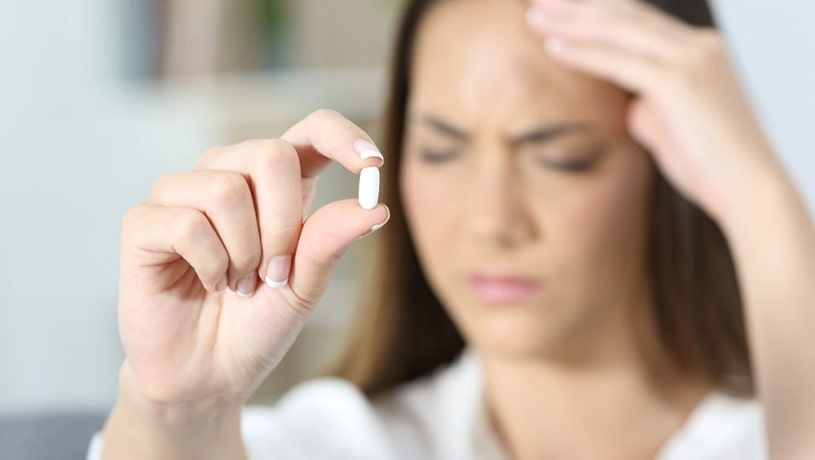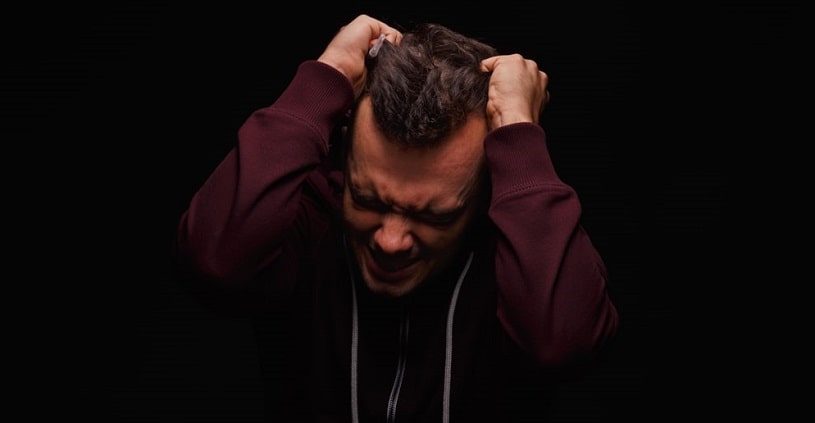Hydrocodone is the most frequently prescribed opioid pain reliever in the United States. This potent medication is used when other pain medicines have been unsuccessful in alleviating symptoms. According to the hydrocodone schedule, it has a high potential for abuse and addiction. People taking the medication must be aware of the information about its health risks and take caution when using this narcotic analgesic.
Table Of Contents:
What Is Hydrocodone?
Hydrocodone is a drug prescribed to treat moderate to severe pain or to suppress the cough. In addition to its generic form, the medication is available under different brand names, such as Vicodin, Lortab, and Norco. These medications present the drug’s common combination with acetaminophen. These immediate-release formulations provide quick pain relief and must be taken every 4-6 hours for continued pain relief. Extended-release pure hydrocodone formulations, such as Zohydro ER and Hysingla ER, are designed for a gradual release of the substance into the body. They provide prolonged pain relief of up to 12 hours. Misuse of both types of formulations can lead to addiction.

More About Opioids:
Doctors advise against the use of alcohol and hydrocodone together because this can result in fatal respiratory depression. In addition, there are many other dangerous interactions, which is why the medicine should only be taken by prescription and under supervision by a physician.
What Is Hydrocodone Used For?
The two main hydrocodone uses are to alleviate pain and suppress the cough. The opioid is available with analgesics for pain relief. The medicine is only prescribed for intractable pain that cannot be managed with safer medicines with a lower risk of addiction.
Hydrocodone for cough consists of combination products that include the narcotic plus an anticholinergic like homatropine or an antihistamine like chlorpheniramine. The cough syrup containing an opioid is a centrally-acting medicine that suppresses the cough reflex. Misuse of these cough syrups can lead to addiction because of their narcotic content.
Hydrocodone Schedule and Drug Class
According to DEA classification, hydrocodone schedule is II, indicating a high risk of physical and psychological dependence and addiction.
Combination opioid analgesic products, for example, hydrocodone homatropine syrup, are some of the most prescribed medicines in the United States. Until 2014, combination products were classified as schedule III drugs, indicating a lower risk of abuse compared to Schedule II drugs. However, the Drug Enforcement Agency (DEA) analysis showed that the addition of non-opioid medications to narcotic analgesics in combination products does not reduce the potential for misuse. To increase awareness and limit over-prescription, combination products were also classified as schedule II drugs in 2014.
Is Hydrocodone a Narcotic?
Hydrocodone drug class is a narcotic analgesic used to treat pain that cannot be controlled with other medications. Narcotics are substances that induce narcosis (insensibility). They are mind-altering compounds that induce sleep. This class of drugs induce drowsiness and relieve pain by binding to opioid receptors in the brain and spinal cord.
Besides weakening pain signals, narcotics create a feeling of intense euphoria and elation, which makes them highly addictive.
Is Hydrocodone an Opiate?
It is not an opiate. It is a semi-synthetic narcotic analgesic that is made by chemically modifying naturally occurring opiates. Opiates are natural opium derivatives extracted from the poppy plant. Examples of opiates include codeine and morphine.
Is Hydrocodone an Opioid?
Hydrocodone classification is a semi-synthetic opioid with a structure and function similar to morphine and codeine.
Opioids bind to the same receptors in the central nervous system as opiates. However, opioids do not occur naturally. Rather, they are either semi-synthetic or synthetic. Synthetic opioids are manufactured entirely in the laboratory. Semi-synthetic opioids are manufactured by a chemical modification of naturally occurring opiates.

Is it an NSAID?
NSAIDs (non-steroidal anti-inflammatory drugs) reduce pain, fever, and inflammation. They are available over-the-counter as Ibuprofen and Naproxen. Hydrocodone bitartrate is not NSAID or muscle relaxant. However, this opioid analgesic is available by prescription in combination products such as Vicoprofen, which contains the opioid, and ibuprofen.
Statistics
The misuse of opiates is a serious public health concern and a national crisis in the United States. People who misuse narcotic analgesics are at risk of addiction as well as overdose symptoms, including coma and death.
Here Are Some Statistics That Reveal the True Extent Of Opioid Abuse:
- Since 2009, this medicine is the second most cited opioid in drug evidence submitted to local, state, and federal forensic labs and DEA tracking systems.
- There is a misconception that prescription medications are safer than street drugs. In 2011 there were more than 82,000 ED visits related to the non-medical use of narcotic pain relievers.
- Monitoring the Future Survey found that 1.2 percent of 12th graders had used Vicodin, a brand name of the opioid, in 2019.
- In 2018, around 70% of 67,367 deaths involved an opioid.
- According to the National Survey on Drug Use and Health, more than 5 million Americans misused this medication in 2019.
- More than 70,000 Americans died in 2019 due to drug-related overdose, including prescription opioids, like Hydrocodone.
Hydrocodone Addiction
Hydrocodone pain pills have a high potential for abuse and addiction. People who are dependent on the medication may experience certain signs and symptoms upon sudden withdrawal from hydrocodone. People who have developed an addiction to prescription pain relievers tend to seek out the drug compulsively. Some addicts attempt to reduce the amount of non-opioid components in combination products to nontoxic levels with techniques such as cold water extraction. However, these processes do not protect them from the dangers of substance addiction and overdose.
Causes Of Hydrocodone Addiction
People who misuse prescription pain pills can develop a tolerance to the drug. Once tolerance develops, the person must take higher doses to achieve the same effect. Tolerance can progress to an addiction to hydrocodone pain pills. Addicts cannot stop taking the drug even if they want to because of physical and psychological dependence. They end up spending an inordinate amount of time trying to obtain, use, and recover from drug use. They continue abusing the medication despite being aware of its negative effects.
Some Causes And Risk Factors Of Prescription Painkiller Addiction Include:
- Genetic predisposition – people who have a first-degree relative with a history of substance use disorders are at higher risk of developing addiction problems.
- Environmental influences – inborn temperament (impulsivity, novelty-seeking nature), peer groups, and family situations can all play a role in developing substance use disorders.
- Chemical dependence– the use of opioids produces artificial feelings of pleasure, and the brain of addicts seeks to experience repeated rewards.
If any of these signs are noticed in someone using hydrocodone pain pills, seek professional help. If the medicine is not used exactly as prescribed, it can quickly progress to chemical dependence and a compulsive need to use the drug regardless of the consequences.
Signs of Abuse
Hydrocodone bitartrate is such a potent drug, thus making it easy for people to develop an addiction. It all starts with a simple prescription and grows to become a chemical dependence. Thereafter, the user develops hydrocodone addiction symptoms evidenced by a compulsive need and strange cravings for the painkiller irrespective of the consequences and circumstances.

The abundance of this painkiller makes it easy to obtain. This is one of the reasons why signs of its abuse disorders are rampant. Abuse signs can be classified into two groups: physical and psychological.
Physical Signs Include:
- Constricted pupils
- Drowsiness
- Lightheadedness
- Withdrawal symptoms when drug use is stopped
- Nausea and vomiting
- Blood clotting issues
- Itching
- Dizziness
Behavioral And Psychological Signs:
- Withdrawal from social activities
- Desire to stop medication use without success
- Inability to fulfill daily responsibilities
- Borrowing or stealing pain medication from other people
- Difficulty thinking – The drug can cause both short-term memory loss and long-term impairment if it is abused continuously
- Anxiety – The drug’s impact on the brain may spill over and cause cognitive problems such as anxiety
- Depression – This has to do with the side effect of hydrocodone abuse on the central nervous system
- Fear – This is mostly caused by imagined as opposed to real threats
- Abnormally cheerful mood -The high feeling brings about a temporal happy mood
- Exaggerating pain or feigning injury to get prescription
- Mood changes and outbursts
- Carrying pills everywhere they go
- Inability to function properly without taking a drug
Despite the above symptoms of abuse, misuse of this drug is pretty hard to recognize. This is because the users maintain a high level of secrecy or exude a certain degree of calm and relaxation that may cause one to be unsuspecting.
However, recognizing the signs and symptoms of substance abuse early enough can potentially save a life. An overdose of hydrocodone in the system can be fatal.
When one realizes that the user is showing signs of hydrocodone addiction, they should immediately act. Delays make a recovery very difficult.
The greatest danger with prescription-based medication is that the patients believe they are following doctors’ orders, hence not concerned with abuse or addiction tendencies.
The best approach is to stage an intervention for a user manifesting physical signs of addiction. There are also specialists who are experienced and can help with rapid detox, among other procedures to rid the system of the drug. The key is choosing the right treatment, which should be patterned based on the patient’s lifestyle and needs.
Hydrocodone Addiction Treatment
The professional hydrocodone addiction treatment is the best option for those who have noticed the warning signs in their loved ones or themselves. There are many opioid dependence therapies available, including medically-assisted treatment and holistic practices like yoga or meditation. Treatment options include a combination of both medication-assisted therapy (MAT) and behavioral therapy.

Due to opioid abuse affecting millions of people, specialists and governments have approved the use of medications as part of addiction treatment to help deal reduce cravings and ease the pain caused by withdrawal. Rehabilitation centers will also provide behavioral therapies after or together with MAT, which is important to secure long-term recovery.
Behavioral Therapies May Include:
- Counseling
- Group therapies
- Dialectical behavioral therapy (DBT)
- Cognitive-behavioral therapy (CBT)
The main goal of addiction treatment is to offer patients the tools they need to live a sober and productive life.
Choosing the Best Addiction Treatment Center
The type of treatment a patient would need will solely depend on a complete evaluation from a doctor. But regardless of the diagnosis, enrolling in a rehab program with progressive levels of care can be very helpful.
Choose a facility that has complete detox programs with 24-hour supervision. One needs full continuum care from medical and clinical staff to give a solid foundation for long-term sobriety. This cannot be achieved easily at home. Inpatient rehab is considered the most intensive type of addiction treatment, especially during the early phases of recovery, and can last for months.
Aside from detox programs, choose a facility that offers to counsel with an addiction expert. A patient needs to know the roots of abuse to treat it effectively, and mental problems are usually intertwined with drug addiction.
Drugs Used for Treatment
Maintaining full recovery after detoxification normally requires medical intervention. Standard treatment for Hydrocodone addiction includes drugs that are meant to lessen the physical side effects and cravings. Maintenance drugs are likewise used to help prevent relapse after addiction treatment.
Buprenorphine
The Food and Drug Administration approved buprenorphine in 2002 to treat Hydrocodone addiction. It is a tablet that dissolves under the tongue and is taken three times weekly and is helpful for detox and long-term Hydrocodone addiction treatment. There are several types of Buprenorphine available in the market. One is Subutex, a pure Buprenorphine, which is used to ease withdrawal symptoms. It interacts with the same brain receptors, producing the same effect, making it less attractive for addiction.
Suboxone
Suboxone is yet another popular type. It contains a mixture of Buprenorphine and Naloxone. Aside from easing withdrawal symptoms, Naloxone reverses the effects of opioid abuse.
The other option is Probuphine. This is an implant that slowly releases the medication during the six months after the insertion. However, it can be costly.
Naltrexone
Naltrexone is an opioid-blocking drug used to help maintain recovery after addiction treatment. This is normally part of hydrocodone addiction treatment at home. By blocking opioid receptors, this drug prevents patients from feeling euphoric.
Group therapy can also be helpful in the treatment of drug addiction. This will give a good support network who can empathize with the recovery journey and give advice.
Recovery From Opioid Addiction
Opioid analgesics are prescription medications, and their use must be carefully supervised by a doctor. Long-term misuse of opioids changes the way the brain perceives pain. In addition, opioid abuse puts a person at risk of cardiac and respiratory arrest, overdose, and death. Addicts who are dependent on opioids must undergo drug detoxing at addiction treatment centers. For pain management, it’s worth comparing hydrocodone vs. Tramadol and other opioid and non-opioid alternatives. If the medication is withdrawn suddenly after prolonged use, it can produce many unpleasant symptoms. Professional withdrawal help can manage these symptoms and cravings to ensure long-term recovery from opioid analgesic abuse. Maintenance treatment can aid in recovery, as well as managing withdrawal symptoms. One should choose the option which suits them and start living a life free of addiction.
Frequently Asked Questions
Does hydrocodone expire?
Like all drugs, opioids have an expiration date. The shelf life of hydrocodone is between 12 and 36 months. However, in many cases, it can last far beyond its expiry date. According to Harvard Medical School, 90% of drugs are perfectly fine to use for up to 100 years after expiring. Despite this, it is not recommended to take drugs after their expiry date, as even a 10% chance could lead to an unwanted situation, with unpredictable side effects.
Does hydrocodone have codeine in it?
Hydrocodone is derived from Codeine. Both are opioids. Both have very similar effects, i.e., both are prescribed as analgesics to relieve pain. Both display a similar mechanism of action to give the same effect. However, the first is 6 times more potent than codeine. The metabolites of hydrocodone include dihydrocodeine, which is metabolically active and similar in function as codeine.
Is hydrocodone a blood thinner?
No, hydrocodone itself does not act as a blood thinner. However, it is paired with other compounds such as NSAIDs (Non-steroidal anti-inflammatory drugs). These can include drugs like ibuprofen, which act on the platelets and alter the way blood clots, thus increasing the risk of bleeding. Therefore, caution should be used for such combination drugs.
Hope Without Commitment
Find the best treatment options. Call our free and confidential helpline
Most private insurances accepted
Page Sources
- Bethesda (MD): National Institute of Diabetes and Digestive and Kidney Diseases, Hydrocodone, 2020. https://www.ncbi.nlm.nih.gov/books/NBK548700/
- PubChem, compound summary: hydrocodone, https://pubchem.ncbi.nlm.nih.gov/compound/hydrocodone#section=Top
- Drug Enforcement Administration, Hydrocodone, 2019. https://www.deadiversion.usdoj.gov/drug_chem_info/hydrocodone.pdf
- Elizabeth H. Crane, Ph.D., EMERGENCY DEPARTMENT VISITS INVOLVING NARCOTIC PAIN RELIEVERS. https://www.samhsa.gov/data/sites/default/files/report_2083/ShortReport-2083.html
- Graziani M, Nisticò R. Gender difference in prescription opioid abuse: A focus on oxycodone and hydrocodone. Pharmacol Res. 2016. https://www.ncbi.nlm.nih.gov/pubmed/27107788
- Alshehri FS, Hakami AY, Althobaiti YS, Sari Y. Effects of ceftriaxone on hydrocodone seeking behavior and glial glutamate transporters in P rats. Behav Brain Res. 2018 Jul 16;347:368-376. https://www.ncbi.nlm.nih.gov/pubmed/29604365
- Medline Plus. Opioid Abuse and Addiction Treatment. 2018. https://medlineplus.gov/opioidabuseandaddictiontreatment.html.
- Miller N. S., Greenfeld A. Patient characteristics and risks factors for development of dependence on hydrocodone and oxycodone. American Journal of Therapeutics. 2004; 11(1):26-32. https://www.ncbi.nlm.nih.gov/pubmed/14704593.
- U.S. National Library of Medicine, Hydrocodone. https://medlineplus.gov/druginfo/meds/a614045.html
- Centers for Disease Control and Prevention, Opioid Overdose: Understanding the epidemic, 2020. https://www.cdc.gov/drugoverdose/epidemic/index.html
- SAMHSA, The National Survey on Drug Use and Health: 2019. https://www.samhsa.gov/data/sites/default/files/reports/rpt29392/Assistant-Secretary-nsduh2019_presentation/Assistant-Secretary-nsduh2019_presentation.pdf
- NIDA, Monitoring the Future Study: Trends in Prevalence of Various Drugs, 2020. https://www.drugabuse.gov/drug-topics/trends-statistics/monitoring-future/monitoring-future-study-trends-in-prevalence-various-drugs
- NIDA, Overdose Death Rates, 2021. https://www.drugabuse.gov/drug-topics/trends-statistics/overdose-death-rates
- L Bevilacqua and D Goldman, Genes and Addictions, 2009. https://www.ncbi.nlm.nih.gov/pmc/articles/PMC2715956/
- Tennessee State Government: Department of Mental Health & Substance Abuse Services, Warning Signs of Drug Abuse. https://www.tn.gov/behavioral-health/substance-abuse-services/treatment---recovery/treatment---recovery/prescription-for-success/warning-signs-of-drug-abuse.html
- U.S. National Library of Medicine, Buprenorphine Sublingual and Buccal (opioid dependence). https://medlineplus.gov/druginfo/meds/a605002.html Harvard Health Publishing, Bad mix: Blood thinners and NSAIDs, 2019. https://www.health.harvard.edu/diseases-and-conditions/bad-mix-blood-thinners-and-nsaids

 Authored by
Authored by  Reviewed by
Reviewed by 


